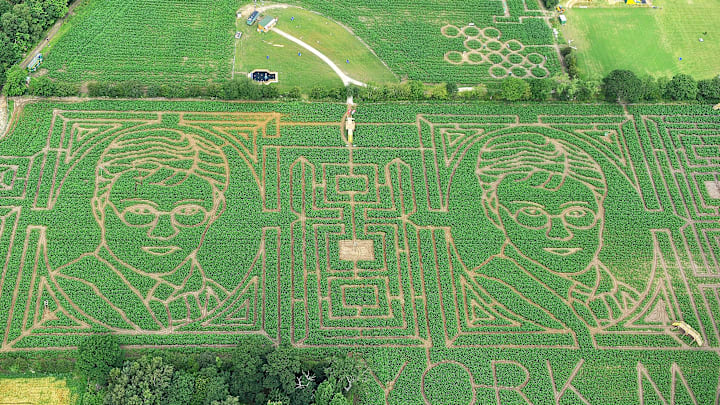The corn maze exists at the unlikely intersection between agriculture and entertainment. Each year, hundreds of farms enlist specialized firms to design mazes that render everything from Sesame Street star Elmo to Marty McFly of Back to the Future fame using stalks of corn. From a bird’s eye view, they’re naturalized works of art. On the ground, they attract visitors as part of the fall farm events industry, which can include everything from pumpkin bowling to carriage rides.
But just how do these firms manage to make a few acres of corn credibly resemble Reba McEntire?
How Corn Mazes Are Made
As the above video from Cheddar illustrates, the implementation of a corn maze is a marriage between technology and organic art tools—in this case, corn.
The impetus for a maze is usually one of two things: a farm looking to bolster business for their open-to-the-public activities calendar, or a company looking to promote a product. (Reba McEntire’s corn portrait was tied to an album release.) Designing the maze typically falls to a business that can work on a corn canvas. MAiZE, a Utah company, has dubbed it “agritainment.”
Logan Bench, CTO of MAiZe, spoke with Slate in 2023 about how the process evolves from there. “We throw it into a vector design program,” he said. “We have some proprietary patterns and grids that are sized to the customer’s field. And really, it’s not rocket science, it’s just a giant connect-the-dots game like on the back of a cereal box, but just way more intense.”
Once they have a design that can be realized in corn, Bench’s next move is making sure the pattern can become a workable maze, with viable paths out of the field.
You May Also Like:
- 12 Secrets of Corn Maze Designers
- 9 of the World’s Coolest Mazes You Can Visit
- The Origins of 25 Fall Traditions
Add Mental Floss as a preferred news source!
The size of the maze matters, too. Larger spaces can fit more detail. (Bench likened corn stalks per foot to pixels per inch: the denser the stalks, the more opportunity for more elaborate renderings.)
Once the design is approved, the field can be prepared in one of two ways. The corn stalks can be planted so the design grows with the corn: A machine guided by GPS can plant corn seeds exactly where they need to be in order to grow into the design of the maze. Or, the corn can be planted across the field and a walking trail that follows the maze can be cut with a tractor and smoothed with a rototiller.
For years, the second method was the most widely-used, but it came with a host of issues. Because farmers have to cut after the fact, a tractor may not have the maneuverability needed to carve out more complex mazes. The arrival of GPS-driven seed specificity—the planting machine essentially just stops depositing seeds over the walking path—was more accurate and less time-consuming.
The type of corn matters, too. Grain corn grows taller than sweet corn, making the maze more immersive.
The Origin of Corn Mazes |
|---|
Corn mazes are widely perceived as predecessors to hedge mazes, the foliage-bordered paths that date back centuries and were originally part of aristocratic landscaping. But the first corn maze is of a much more recent vintage: In 1993, Don Frantz, a marketing advisor, was flying over a corn field in an airplane when he had the idea to depict something using the stalks. His first project, a rendering of a dinosaur dubbed “Cornelius the Cobasaurus,” was created by pulling the corn up by hand. The innovation soon spread to other farms, which used the increasingly elaborate designs to fuel an alternative revenue stream. |
Solving Corn Mazes
Corn mazes are one-part marketing tool and one-part escape room. Some designers use tiers in their mazes, with an easier exit followed by a path that’s more difficult to resolve.
“A lot of our mazes will actually have two to three different phases, and so essentially there’s three different mazes, but it looks like one,” Bench told Slate. “And what that does is it gives the customer the option to say, ‘OK, I did Phase 1. I’m tired. I want to go get a corn dog.’ Or if they want more, then they continue to Phase 2.”

Is there a strategy for corn mazes? It depends on their complexity. Less complicated mazes may have walls that are all interconnected and attached to the exterior border. If one were to continually make right turns, one would eventually come out of it.
But the increasing detail of mazes has given way to “islands,” or roundabout spaces, where walls are no longer one continuous chain. This can lead to a lot of backpedaling, though stubbornness can usually get you out the other side.
Some mazes, however, can prove a little too immersive. In 2011, a family phoned 911 after getting lost in a Massachusetts labyrinth. It had gotten dark and a baby was with them. Luckily, a police officer and their dog were able to locate them quickly.
